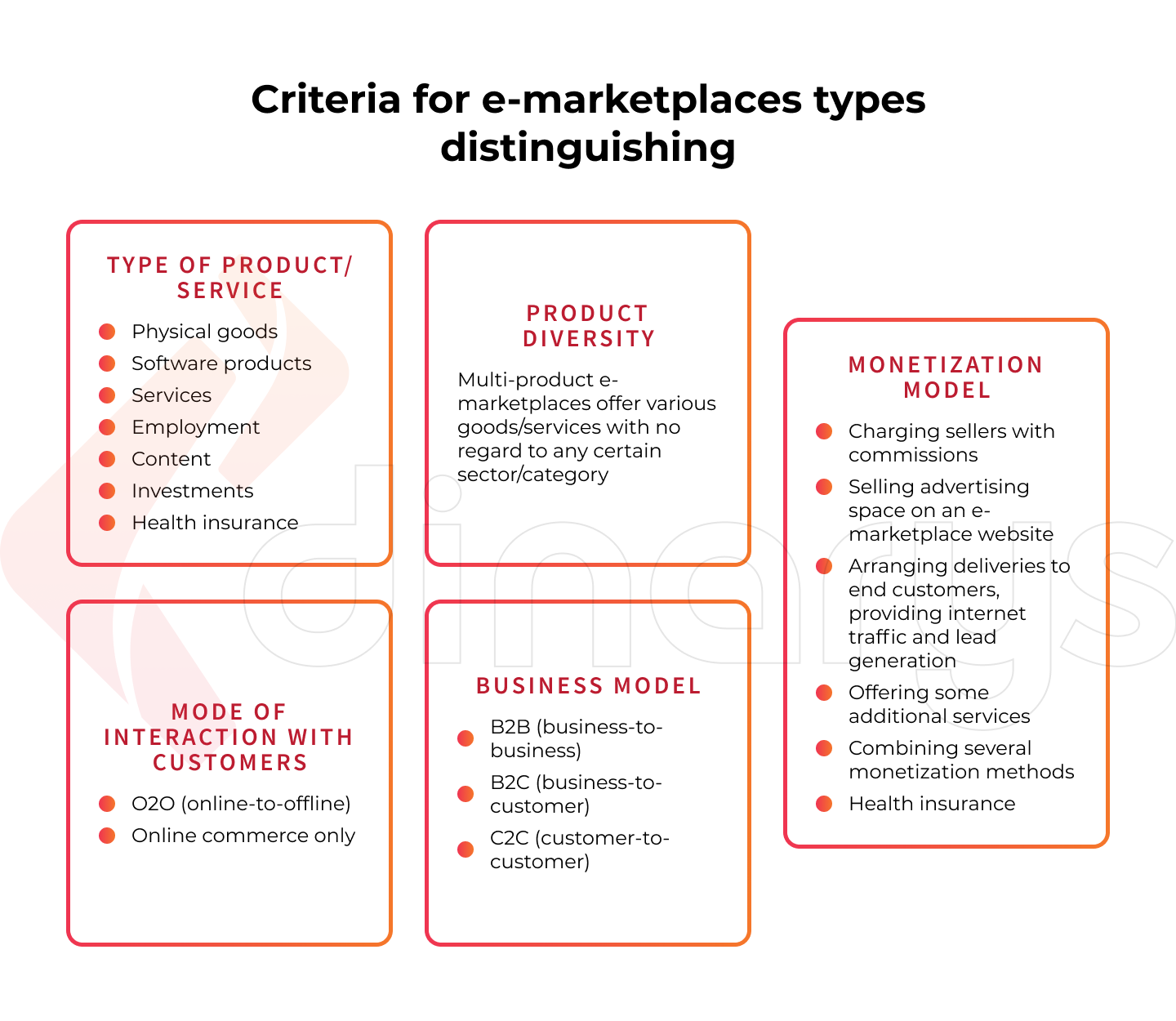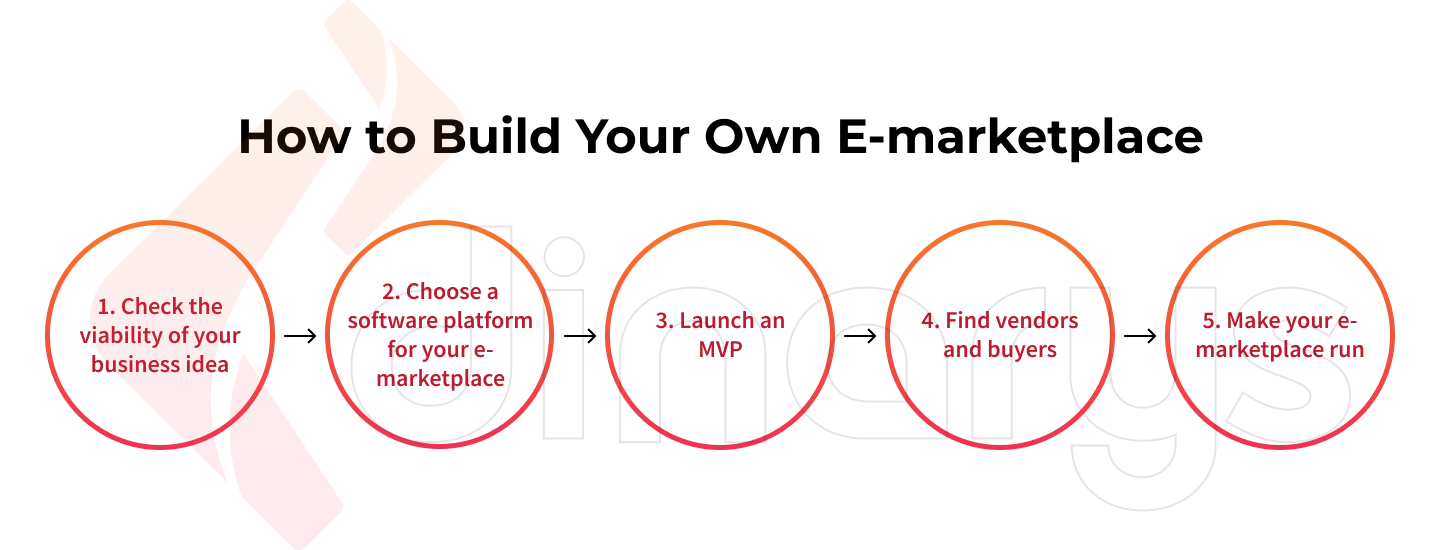Content
E-marketplace Boom: Why Multi-Vendor Platforms Promise to Keep Thriving

Time to read: 15 minutes
According to stats, the annual turnover of the top online marketplaces reached $2.67 trillion in 2020. Some of them such as Etsy (USA) and Ozon (Russia) showed 100% growth while the average growth rate increased by 29% across the sector. The top 100 marketplaces occupy about 62% of the global online sales. The trend continued in 2021 as well: the compound (2019-2021) growth rate of the Dutch marketplace Takeway.com, for example, reached 252%.
.png)
Against the background of the global economic stagnation due to the COVID pandemic, such achievements of online marketplaces really impress. What allows them to keep evolving so sustainably? The question can hardly be answered without diving deeply into the very nature of online marketplaces. What types of e-marketplaces are available? How do they differ from ordinary e-stores? And when is it worth using an e-marketplace instead of building your own online shop?
Lets talk about itHave a project in mind?
We are going to address the most interesting features of different types of e-marketplaces in the present post to help business owners realize all the pros and cons of marketplace development.
What Is an E-marketplace?
To put it simply, an online marketplace is a web-based platform through which sellers and buyers find each other to interact. Various state health insurance marketplace types, for instance, help users find the most appropriate health insurance plans providers. Such a brief definition, however, does not explain how the process goes. Let’s define e-marketplaces more explicitly: an online marketplace is an intermediary entity between suppliers and consumers that bears responsibility for the following critical accomplishments:
- Creating, running, and maintaining a website and mobile applications dedicated to the online trading platform
- Investing time and money in the engagement of new users
- Providing secure purchases and payments
- Delivering goods to buyers as well as storing the sellers’ products at physical storehouses
- Proceeding with all the other administrative and commercial affairs that facilitate online trading
The main value of an e-marketplace for sellers is in the efficient distribution mechanism capable of driving new customers to the sellers’ products. Consumers, in turn, appreciate e-marketplaces for an opportunity to buy everything they need in one place without wasting time.
Different types of e-commerce marketplaces may have a distinct focus on what to offer beginning from consumer goods for all occasions and up to various sectoral services (finance, health insurance, consulting, etc). Both companies and individuals (when the “customer-to-customer” scenario is available) can be suppliers on e-marketplaces.
How Do E-marketplaces Differ from E-stores?
Only a few critical differences are available between online marketplaces and ordinary e-commerce websites. Even though there are several types of online marketplaces, the following set of differences remain the same:
Number of sellers and goods
A conventional online shop usually offers goods from either one supplier (the so-called mono-brand e-stores) or several ones whose products constitute a group of products that somehow complement each other: auto parts, clothes, sports nutrition, health insurance plans, etc. In contrast, various types of e-marketplaces gather numerous suppliers that offer a great variety of goods/services going far beyond any certain category. Thus, e-marketplaces are akin to large shopping malls while e-stores are similar to boutiques when being compared.
Offline infrastructure
Many e-shops are just online manifestations of already available brick-&-mortar stores. Moreover, the online versions of such stores are oftentimes inferior to the offline infrastructures in many aspects: product diversity, trade volume, capital investment, number of staff, etc. In contrast, almost any type of online marketplace has no trading facilities in the physical reality. Their offline infrastructure can include storehouses and, at best, a fleet of vehicles for delivery.
Customer audience and location
In general, e-marketplace spends much more resources on customer engagement than ordinary e-shops do. On the one hand, every type of e-marketplaces has larger financial capabilities. On the other hand, their development (if not survival) depends on the continuous expansion across different local markets. That’s why a typical e-marketplace has more intensive internet traffic with a more diverse user audience in comparison with a typical e-store. Besides, e-marketplaces pay special attention to logistics and delivery services to cover as wide an area as possible.
Types of E-marketplaces: Criteria for Distinction
We at Dinarys propose to consider 5 basic criteria with which different types of e-marketplaces can be distinguished.
Type of product/service
The product range has long ceased to be the only distinctive feature for different e-marketplaces. Goods, services, information (content), and even investments are what various e-marketplaces offer to customers today. The following examples reflect who offers what in the online marketplace segment to name a few:
- Physical goods: eBay, Amazon, Aliexpress, OLX, Etsy
- Software products: Google Play, Apple Store, Mi Store, Windows app store, GitHub
- Services: Uber, Airbnb, Booking.com
- Employment: Upwork, Dribble, Behance
- Content: Twitch, YouTube, Spotify
- Investments: Kickstarter, Indiegogo, CircleUp
- Health insurance: Molina, Caresource, Helathcare.gov
Business model
This criterion determines who is a seller and who is a buyer on a certain e-marketplace. Of course, there are several types of e-marketplaces where all available combinations of business models are mixed. But in general, the following 3 business models are widely accepted:
- B2B (business-to-business): This is when companies offer their products/services to other companies. Examples: Made-In-China, Exporthub, Alibaba.
- B2C (business-to-customer): The most popular business model when companies offer products/services to end customers. Examples: Amazon, Aliexpress, Taobao.
- C2C (customer-to-customer): Usually, this model goes in parallel with B2C, but some e-marketplaces are especially focused on the C2C model. Examples: eBay, OLX, Etsy.
Product diversity
Multi-product e-marketplaces offer various goods/services with no regard to any certain sector/category. In contrast, specialized e-marketplaces offer only “niche” products: you can buy nothing but mobile apps on Google Play. When compared to offline stores, you can buy almost any kind of product in Auchan (food, clothes, books, etc) as opposed to Leroy Merlin where products for house and garden only are offered.
Mode of interaction with customers
All types of e-marketplaces have only two basic modes of interaction with customers:
- O2O (online-to-offline): This is when customers select products via an online platform but the actual delivery of the goods is conducted via either physical pick-up areas or courier shipping. The same relates to services. Examples: Wildberries, Uber.
- Online commerce only: All interactions between an e-marketplace and customers occur via the internet. Such a mode rarely relates to physical goods. Examples: Apple Store, YouTube.
Monetization model
Different types of online marketplaces earn money in different ways:
- Charging sellers with commissions. Aliexpress, for instance, charges each sale with different fees depending on the type of products: furniture, consumer electronics, shoes, and jewelry cost 5% while sellers of clothes, cosmetics, watches, and baby goods have to pay 8% as a seller’s fee. At the same time, the first 100 deals during 6 months bear zero commission.
- Selling advertising space on an e-marketplace website.
- Arranging deliveries to end customers.
- Providing internet traffic and lead generation.
- Offering some additional services.
- Combining several monetization methods.

Pros and Cons of Online Marketplaces
Only one main attractor of e-marketplaces for buyers seems to exist: a broad diversity of products to select. Sellers, in contrast, can recognize various advantages in doing business via e-marketplaces: launching projects from scratch with no significant investment, getting access to new markets, covering a larger customer audience, and receiving well-targeted traffic.
It is worth considering the advantages and drawbacks of various types of online marketplaces in more detail, however.
Advantages
Reasons for either using e-marketplaces as a tool for online trading or building your own e-marketplace are not limited by the following ones. We have generalized the main pros for your convenience only.
- E-marketplaces invest a lot in advanced marketing, care about customers’ feedback, and improve their services continuously. They spare no expense for promotion, physical storehouses, and pick-up areas. All of this leads to greater popularity of their platforms among growing user audiences. That’s why sellers can focus on both the quality and diversification of their product range instead of being bothered by customer engagement.
- All types of e-marketplaces offer well-organized order processing, secure payments, and fast delivery. Hence, all sales tools are ready to use, what remains is just to complete registration on the website and add your products to the catalog. Besides, the revenue generated from trading on e-marketplaces (even with all charged fees) is higher than returns on similar sales conducted via offline wholesale channels.
- Many e-marketplaces have already entered the international markets: they can easily undertake operations with foreign currencies. On the one hand, you can sell products throughout the world. On the other hand, you need no reporting to your local national bank.
- Many types of e-marketplaces offer dispute resolution services. Besides, they provide quality verification and standard compliance that contribute a lot to customers’ loyalty.
- E-marketplaces represent advanced sales analytics: you can see total gross sales, orders vs purchases ratio, accurate identification of product shortages, and other useful info allowing to build successful sales strategies.
- E-marketplaces usually offer advanced customer support that allows sellers to save a lot on calls, staff, and time spent on communication with customers.
Lets talk about itHave a project in mind?
Drawbacks
Some specific threats are inherent in doing business via different types of online marketplaces. The following drawbacks should be considered as potential cons rather than actually available ones. Nonetheless, forewarned is forearmed, as they say.
- Customer loyalty to any particular seller can be affected if the corporate e-marketplace customer service is getting worse.
- Numerous sellers offer similar goods since e-marketplaces are interested in collecting as many sellers as possible. The goods’ displaying algorithm is usually set to show the cheapest/most popular offers while the sellers have no opportunity to change it. Even if customers visit an e-marketplace with your product in mind, they can easily follow advertising to find some other sellers.
- The return of the goods can result in extra expenses for sellers. You will pay the same money for returning goods to the e-marketplace warehouse as for delivering goods to end customers. That’s what is happening on Ozon, for instance.
- Sellers entrust the future of their businesses to a certain type of e-marketplace when they accept the terms of use. But the terms can change. What if the cost of storage voluntarily increased by 20% a week after you delivered your goods to the marketplace warehouse? E-marketplaces can modify their terms of use frequently and, sometimes, covertly. This can affect the financial planning of sellers.
- Sellers have to follow the campaigns and seasonal discounts initiated by the e-marketplace. Otherwise, they have to hide some products from customers so as not to violate the rules of the platform. At the same time, the sellers have to coordinate their own unique campaigns with e-marketplaces.
- Sellers can face various pitfalls regarding the level of fees (different products can be charged with different fees), extra expenses for storage, cost of delivery, etc. It is necessary to examine all terms and conditions before signing a contract with a particular type of e-marketplace.
- E-marketplaces usually do nothing against replication of goods that results in appearing clones of popular brands (as has happened with Amazon, for example) when both reputation and revenue of fair vendors suffer.

Tips on Doing Trade on E-marketplaces
Despite numerous attractive opportunities, online marketplaces can hardly be the one-fits-all solution for each and every vendor. Besides, there are different types of online marketplaces, and selecting the right one is critical not to fail in business. The following tips can help realize whether the online marketplace is a worthwhile approach and, if so, which e-marketplace is better to choose.
When using e-marketplaces makes sense
As a general rule, e-marketplaces appear effective for those vendors who are not going to promote their products on their own. The promotion includes logistics and storage in such a context. Large e-marketplaces with sustainable customer flow help those vendors find their audiences. E-marketplaces seem to be the best choice for the sellers that mimic popular brands. Besides, small e-stores can expand their audiences by using e-marketplaces as an additional channel of sales.
What to sell on e-marketplaces
Products with stable and high demand are worth selling on e-marketplaces. The marketplace’s sales mechanism is based on search algorithms. In most cases, customers visit various types of e-marketplaces with a clear idea of what to buy. Sellers should keep the price/quality ratio of their products not worse than their competitors do. Even if a certain e-marketplace offers a “one product - one supplier” scenario, customers always have opportunities to compare every particular product with similar ones offered by other e-marketplaces. Experts indicate auto parts, toys, smartphones/tablets, food, and hand-made products as the most appropriate items to sell on e-marketplaces.
Cooperation models proposed by e-marketplaces
Various types of e-marketplaces offer different scopes of options to sellers. However, the following frameworks of cooperation seem to be most typical:
- Storefront only: An e-marketplace carries out neither delivery nor customer service via such a model. Vendors have to arrange everything on their own while handling orders.
- Storefront + delivery: Vendors deliver their goods to the e-marketplace storehouse while the platform arranges shipping of purchased goods to end customers.
- Fulfillment: This all-in-one model covers various services available on a certain type of e-marketplace for vendors (storage, package, delivery, customer support, etc). New options appear regularly to catch new vendors.
How to assess e-marketplaces
The following criteria help figure out which type of e-marketplaces can be the most appropriate for a particular vendor.
- The most decisive indicator of any e-marketplace includes both the number of vendors and the user audience. This reflects the trust of users as little else does.
- The number of direct competitors already available on an e-marketplace is critical for any vendor especially in relation to a potential target audience. If there are 1000 similar sellers per every 5 thousand potential buyers, any new seller can hardly do profitable business there.
- Experts suggest using several e-marketplaces simultaneously since even the top ones can not cover all potential buyers. Besides, the experience gained from one e-marketplace can help a seller build a more profitable business on other platforms.
- It is worth paying attention to the registration procedure: numerous sales options and clear advantages of a certain type of e-marketplace can be neutralized by the restrictions and limitations (such as the necessity to have an official trademark) appearing when a certain category of vendors (self-employed individuals, for instance) try to create a profile.
Lets talk about itHave a project in mind?
How to Build Your Own E-marketplace
Let’s try to address the subject from another angle: why not build your own e-marketplace? There is every indication that running an e-marketplace is as promising as sustainable in terms of business activity. Hence, if there is a strong decision to create your own e-marketplace, the following questions should find their answers first of all:
- Why should just this type of e-marketplaces appear?
- What will vendors sell on the new e-marketplace?
- Who will buy what the vendors sell on the e-marketplace?
In other words, the type/business model of a new e-marketplace (B2B, B2C, C2C, mixed), the sort of items to sell (products, services, investments, etc), and the targeted customer audience (local, international) all can determine the architecture, development technologies, design, user interface, payment gateways, and other parameters of the desired platform.
The following algorithm of proceeding is worth applying to the creation of your own e-marketplace:
Check the viability of your business idea
After a general image of your e-marketplace has been formed in your mind (for example, a B2C + C2C model for selling consumer goods at a local market), you should figure out whether your business idea has a chance to compete with the available rivals. The best approval of the viability of your project is the interest that both potential sellers and buyers demonstrate against your proposition. There can be two basic approaches to the issue:
- Conduct interviews with a targeted user audience. Ask both potential sellers and buyers about the key features they would like to see on the new platform. Get clear feedback from your future users about the conditions under which they can become your customers. Use all available communication channels to reach as many respondents as possible.
- Study search queries. There are various SEO tools (Google Trends, etc) that can provide you with the “burning” topics that people are interested in. Use the most relevant keywords to see how many potential users are looking for the products you are going to sell via your e-marketplace.
After making sure that your business idea resonates with the actual needs of both sellers and buyers, you can take another step forward.
Choose a software platform for your e-marketplace
Your future success directly depends on the performance and scope of features that chosen software is able to provide. Both tailor-made platforms and out-of-the-box solutions are available to select from. With no regard to the origin you should assess the software with the following criteria:
- Price/functionality ratio. It is worth studying reviews of the available types of e-marketplaces to realize which functionality is a must-have and which one is optional. Besides, the variety of ready-to-use solutions implies a broad price range. A certain software competency won’t go amiss to look into the matter. Professional developers are always to the rescue with their expertise.
- Quick start and ease of use. Such a serious project as an e-marketplace must be preceded by MVP (minimum viable product) not to waste time and money on anything unviable. Out-of-the-box solutions rarely provide such an opportunity. And even if so, setting up such an MVP can hardly be called user-friendly. Custom software, in contrast, can easily act as an MVP with subsequent upgrading to a fully-fledged e-marketplace platform. The usability of any software depends on various factors such as the core technology, settings, number of features, integrations, scaling-up capabilities, etc. Needless to say that the usability of custom-made solutions is under full control of its owners while out-of-the-box systems make users face a “fait accompli”.
- Customers’ feedback. Study the opinions that users share about the selected platforms. There are several specific internet resources such as Capterra, SourceForge, and G2 where e-marketplace platforms are discussed.
Launch an MVP
MVP is the fastest and cheapest way to put your business idea into action. When selecting an MVP you should clarify the following issues with MVP developers:
- Whether they provide deployment, technical support, updates, and maintenance. Launching an e-marketplace MVP is a more complicated process than just setting up a mobile application: a certain technical competence in servers is required. Complex technical support from the MVP developers is a must if you are not too tech-savvy.
- Whether the selected MVP is capable of scaling up. Make sure that the MVP functionality can be extended with modules and code modifications. As your business will evolve, the MVP should cope with growing loads.
- How much it will cost to launch the MVP within a day or so. The solution should not be expensive in the initial configuration allowing to launch an MVP as fast as possible. Remember that this is just a trial run of your business idea, no significant investment makes sense.
Find vendors and buyers
Launching an MVP shows that you have already set the stage for running your e-marketplace. It means you know your user audience. Start your promotional campaigns on social media to catch as many sellers and buyers as possible. Discounts, special offers, coupons, free trial periods all can do when you enter the market.
Make your e-marketplace run
The evolution from an MVP to a fully-fledged e-marketplace can happen steadily and even quietly. Your modus operandi seems clear in this regard:
- Follow your users’ feedback to upgrade your e-marketplace with the desired options.
- Never interrupt promoting your platform across online media.
- Don’t be averse to replicate successful marketing approaches used by the leading e-marketplace platforms.
- Adapt your competitors’ ideas to develop your business.

Conclusion
Even though not too many types of e-marketplaces are available, it is worth being aware of their nuances to distinguish one from the other. When you are going to either do your business via online marketplaces or launch your own e-marketplace platform, different types of e-commerce marketplaces will require a certain competence from you not to fail afterward.
The best approach to the issue involves professional e-marketplace creators. They can consult on every aspect inherent in the creation, deployment, and running of an online marketplace of any type.
Contact us today to get professional assistance from the e-marketplace experts capable of meeting any business challenge that the marketplace sector may give rise to.
FAQ
The very definition of health insurance implies a certain type of service. Hence, any health insurance e-marketplace offers related services in both B2B and B2C business models (C2C is not relevant to the sector according to common logic). Both private e-marketplaces and state-owned ones (such as healthcare.gov, for instance) are available in the segment. Experts suggest selecting health insurance e-marketplaces through the lenses of your own health insurance plan. Location is important as well.
This is a special healthcare insurance-centric platform that offers various health insurance plans. More than 2 million users of the platform prove the relevance of such a business model for the contemporary health insurance industry. The details about the platform are available on the official website.
Molina Healthcare is one of the largest care management providers in the US. Both Medicaid and Medicare governmental insurance programs are in the scope of the Molina Marketplace (also known as Molina Exchange) that provides various health insurance plans. Customers from different States appreciate the service due to numerous options and advantages. Visit the official website to learn more.
Let professionals meet your challenge
Our certified specialists will find the most optimal solution for your business.



